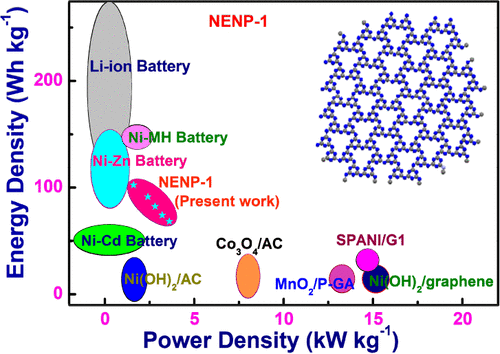当前位置:
X-MOL 学术
›
ACS Sustain. Chem. Eng.
›
论文详情
Our official English website, www.x-mol.net, welcomes your
feedback! (Note: you will need to create a separate account there.)
Nitrogen-Enriched Nanoporous Polytriazine for High-Performance Supercapacitor Application
ACS Sustainable Chemistry & Engineering ( IF 7.1 ) Pub Date : 2018-03-20 00:00:00 , DOI: 10.1021/acssuschemeng.7b04254 Monika Chaudhary 1 , Arpan Kumar Nayak 2 , Raeesh Muhammad 1 , Debabrata Pradhan 2 , Paritosh Mohanty 1
ACS Sustainable Chemistry & Engineering ( IF 7.1 ) Pub Date : 2018-03-20 00:00:00 , DOI: 10.1021/acssuschemeng.7b04254 Monika Chaudhary 1 , Arpan Kumar Nayak 2 , Raeesh Muhammad 1 , Debabrata Pradhan 2 , Paritosh Mohanty 1
Affiliation

|
Polytriazine with high nitrogen content (c.a. 50.5 wt %) has been synthesized by an ultrafast microwave-assisted method using melamine and cyanuric chloride. The nitrogen-enriched nanoporous polytriazine (NENP-1) has exhibited high specific surface area (maximum SABET of 838 m2 g–1) and narrow pore size distribution. The NENP-1 has been employed as electrode material for supercapacitor application. A maximum specific capacitance (Csp) of 1256 F g–1 @1 mV s–1 and 656 F g–1 @1 A g–1 are estimated from the cyclic voltammetry (CV) and galvanostatic charge/discharge (GCD) measurements, respectively, in a three-electrodes configuration. This Csp value is considered as very high for a nonmetallic system (organic polymer). Superior capacitance retention of 87.4% of its initial Csp was observed after 5000 cycles at a current density of 5 A g–1 and demonstrates its potential as an efficient electrode material for practical applications. To test this claim, an asymmetric supercapacitor device (ASCD) was fabricated. The Csp values of the device in the two-electrode configuration are 567 F g–1 @5 mV s–1 and 287 F g–1 @4 A g–1 in the CV and GCD measurements, respectively. The ASCD has shown superior energy density and power density of 102 Wh kg−1 and 1.6 kW kg–1, respectively, at the current density of 4 A g–1. The energy density is much higher than the best reported supercapacitors and also close to the commercial batteries. This indicates the material could bridge the gap between the commercial batteries and supercapacitors.
中文翻译:

用于高性能超级电容器的富氮纳米多孔聚三嗪
使用三聚氰胺和氰尿酰氯通过超快微波辅助方法合成了高氮含量(约50.5 wt%)的聚三嗪。富氮纳米多孔聚三嗪(NENP-1)具有较高的比表面积(最大SA BET为838 m 2 g –1)和狭窄的孔径分布。NENP-1已被用作超级电容器应用的电极材料。最大比电容(C sp)为1256 F g –1 @ 1 mV s –1和656 F g –1 @ 1 A g –1它们分别以三电极配置从循环伏安法(CV)和恒电流充/放电(GCD)测量中估算。对于非金属体系(有机聚合物),该C sp值被认为是非常高的。在5 A g –1的电流密度下经过5000次循环后,可以观察到其初始C sp的优良电容保持率为87.4%,并证明了其作为实用电极材料的潜力。为了测试该要求,制造了不对称超级电容器器件(ASCD)。在双电极配置中,设备的C sp值为567 F g –1 @ 5 mV s –1和287 F g –1 @ 4 A g –1分别在CV和GCD测量中。所述ASCD已经显示出优良的能量密度和102瓦公斤的功率密度-1和1.6千瓦千克-1分别在4 A G的电流密度-1。能量密度远高于报道最好的超级电容器,并且也接近商用电池。这表明该材料可以弥合商用电池和超级电容器之间的间隙。
更新日期:2018-03-20
中文翻译:

用于高性能超级电容器的富氮纳米多孔聚三嗪
使用三聚氰胺和氰尿酰氯通过超快微波辅助方法合成了高氮含量(约50.5 wt%)的聚三嗪。富氮纳米多孔聚三嗪(NENP-1)具有较高的比表面积(最大SA BET为838 m 2 g –1)和狭窄的孔径分布。NENP-1已被用作超级电容器应用的电极材料。最大比电容(C sp)为1256 F g –1 @ 1 mV s –1和656 F g –1 @ 1 A g –1它们分别以三电极配置从循环伏安法(CV)和恒电流充/放电(GCD)测量中估算。对于非金属体系(有机聚合物),该C sp值被认为是非常高的。在5 A g –1的电流密度下经过5000次循环后,可以观察到其初始C sp的优良电容保持率为87.4%,并证明了其作为实用电极材料的潜力。为了测试该要求,制造了不对称超级电容器器件(ASCD)。在双电极配置中,设备的C sp值为567 F g –1 @ 5 mV s –1和287 F g –1 @ 4 A g –1分别在CV和GCD测量中。所述ASCD已经显示出优良的能量密度和102瓦公斤的功率密度-1和1.6千瓦千克-1分别在4 A G的电流密度-1。能量密度远高于报道最好的超级电容器,并且也接近商用电池。这表明该材料可以弥合商用电池和超级电容器之间的间隙。











































 京公网安备 11010802027423号
京公网安备 11010802027423号